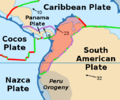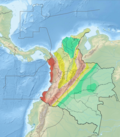Murindó Fault
| Murindó Fault | |
|---|---|
| Falla Murindó | |
| Etymology | Murindó |
| Coordinates | 06°45′55″N 76°39′12″W / 6.76528°N 76.65333°W |
| Country | |
| Region | Pacific/Chocó |
| State | Antioquia, Chocó |
| Cities | Dabeiba |
| Characteristics | |
| Range | Chocó Basin, Western Ranges, Andes |
| Part of | Andean strike-slip faults |
| Length | 60.6 km (37.7 mi) |
| Strike | 347.4 ± 6 |
| Dip | East |
| Dip angle | High |
| Displacement | 0.2–1 mm (0.0079–0.0394 in)/yr |
| Tectonics | |
| Plate | North Andean |
| Status | Active |
| Earthquakes | 18 October 1992 (MW 7.3) |
| Type | Strike-slip fault |
| Movement | Sinistral |
| Age | Quaternary |
| Orogeny | Andean |
The Murindó Fault (Spanish: Falla Murindó) is a strike-slip fault in the department of Antioquia and Chocó in northwestern Colombia. The fault has a total length of 60.6 kilometres (37.7 mi) and runs along an average north-northwest to south-southeast strike of 347.4 ± 6 in the Chocó Basin along the western edge of the Western Ranges of the Colombian Andes.
Etymology
[edit]The fault is named after Murindó.[1]
Description
[edit]The fault in the Chocó Basin extends along the western slope of the Western Ranges of the Colombian Andes, from the Arquia River in the south to the Río Sucio and the basin of the Atrato River in the north. The Murindó Fault places Cretaceous volcanic (basic) rocks against Tertiary turbidites, and crosscuts Tertiary quartz-diorite and granodiorite.[1] The Murindó River flows along the Murindó Fault near Murindó.[2] The fault underlies the municipalities of Dabeiba and Frontino.[3] To the south, the fault runs parallel to the Mutatá and Encarnación Faults.[4][5]
In the southernmost part, the fault shows evidence of tectonic control of streams. It also forms aligned saddles that face toward the mountain front. The fault is active with an approximate slip rate of 0.2 to 1 millimetre (0.0079 to 0.0394 in) per year, and caused the 1992 Murindó earthquake (MW 7.3) on October 18. A foreshock of 6.7 was registered the day before. Many earthquakes that occurred since 1883 in the region are associated with the Murindó Fault.[6]
See also
[edit]References
[edit]Bibliography
[edit]- Paris, Gabriel; Machette, Michael N.; Dart, Richard L.; Haller, Kathleen M. (2000), Map and Database of Quaternary Faults and Folds in Colombia and its Offshore Regions (PDF), USGS, pp. 1–66, retrieved 2017-09-18
Maps
[edit]- Paris, Gabriel; Machette, Michael N.; Dart, Richard L.; Haller, Kathleen M. (2000), Map of Quaternary Faults and Folds of Colombia and Its Offshore Regions (PDF), USGS, p. 1, retrieved 2017-09-18
- Cossio, Ubaldo; Zapata, Gilberto (2007), Plancha 113 - Murindó - 1:100,000, INGEOMINAS, p. 1, retrieved 2017-06-06
- Cossio, Ubaldo; Zapata, Gilberto (2002), Plancha 128 - Murrí - 1:100,000, INGEOMINAS, p. 1, retrieved 2017-06-06
- Londoño, Ana Cristina; González, Humberto (2002), Plancha 129 - Cañasgordas - 1:100,000, INGEOMINAS, p. 1, retrieved 2017-06-06
- González, Humberto (2002), Plancha 145 - Urrao - 1:100,000, INGEOMINAS, p. 1, retrieved 2017-06-06
Further reading
[edit]- Page, W.D (1986), Seismic geology and seismicity of Northwestern Colombia, San Francisco, California, Woodward-Clyde Consultants Report for ISA and Integral Ltda., Medellín, pp. 1–200




